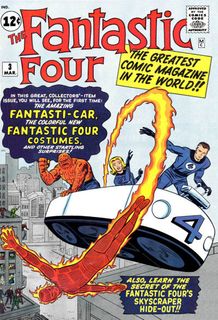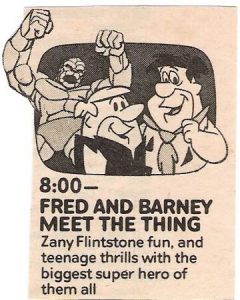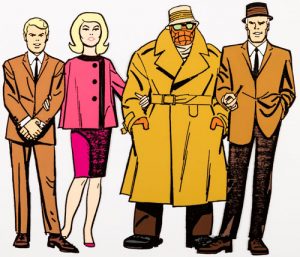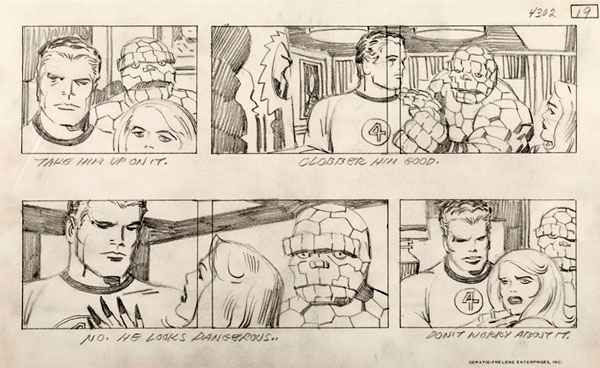
Hanna Barbera’s FANTASTIC FOUR (1967) re-designed for animation by Alex Toth
Suspended Animation #325
The Fantastic Four was a Marvel comic book created by writer Stan Lee and artist/co-plotter Jack Kirby in 1961 and became a huge success prompting their appearance on radio, merchandise and later live action movies.
 These four fantastic characters gained their superpowers after exposure to cosmic rays during a mission in outer space. Reed Richards, the scientific genius and leader of the group, was Mister Fantastic who could stretch his body to incredible lengths and shapes.
These four fantastic characters gained their superpowers after exposure to cosmic rays during a mission in outer space. Reed Richards, the scientific genius and leader of the group, was Mister Fantastic who could stretch his body to incredible lengths and shapes.
Sue Storm was the Invisible Woman who could render herself invisible and project invisible force fields. Her younger brother Johnny Storm was the Human Torch who could generate flames and fly. Ben Grimm, their grumpy friend, was The Thing who possessed tremendous strength because of his stone-like flesh.
Over the decades there have been four distinct animated television series trying to translate these characters and their stories to animation.
• Fantastic Four (1967-1968) produced by Hanna-Barbera ran for one season comprising 20 episodes. The show featured character designs by Alex Toth.
• The New Fantastic Four (1978) produced by DePatie-Freleng Enterprises ran for one season comprising 13 episodes. The Human Torch was replaced with a robot named H.E.R.B.I.E. (Humanoid Experimental Robot, B-type, Integrated Electronics). Stan Lee, Roy Thomas and Jack Kirby were involved with the series.
 • Fred and Barney Meet the Thing (1979) was an animated programming block which incorporated two TV shows: The New Fred and Barney Show (a Flintstones spin-off) and The Thing. The Thing ran for twenty-six 11-minute episodes and told the story of teenager Benjy Grimm living in contemporary times, who had a pair of magic Thing-rings which could transform him into the Thing when he put them together and said “Thing-ring, do your thing!” No other members of the Fantastic Four appeared or were mentioned in this series and the character never actually met Fred and Barney except in short comedic interstitials.
• Fred and Barney Meet the Thing (1979) was an animated programming block which incorporated two TV shows: The New Fred and Barney Show (a Flintstones spin-off) and The Thing. The Thing ran for twenty-six 11-minute episodes and told the story of teenager Benjy Grimm living in contemporary times, who had a pair of magic Thing-rings which could transform him into the Thing when he put them together and said “Thing-ring, do your thing!” No other members of the Fantastic Four appeared or were mentioned in this series and the character never actually met Fred and Barney except in short comedic interstitials.
• Fantastic Four: The Animated Series (1994 – 1996) originally aired as part of The Marvel Action Hour – an hour-long programming block that paired the FF show up with Iron Man: The Animated Series. Fantastic Four: The Animated Series ran for 26 episodes across two seasons, with the characters also appearing as guest stars in The Incredible Hulk: The Animated Series and Spider-Man: The Animated Series which aired during the 1990s.
• Fantastic Four: World’s Greatest Heroes (2006) was an American-Canadian-French production which ran for one season totalling 26 episodes. During its initial run its schedule was erratic with only the first eight episodes airing. All the episodes finally aired in 2009 when the show moved to Nicktoons.
 The Fantastic Four were originally going to be part of the 1966 Grantray Lawrence Marvel Super Heroes syndicated animation series but wisely, Marvel decided not to allow it. The X-Men and the Avengers did appear in episodes.
The Fantastic Four were originally going to be part of the 1966 Grantray Lawrence Marvel Super Heroes syndicated animation series but wisely, Marvel decided not to allow it. The X-Men and the Avengers did appear in episodes.
The original Hanna-Barbera version of the quartet did not meet the expectations of Marvel fans who felt it missed the magic of the comic book with too simple, action filled stories that looked no different than any of the other H-B superhero shows of the time and none of the clever dialog. The episodes were a mixture of watered-down adaptations of the comics and original stories.
Almost a decade later in 1978, Marvel partnered with DePatie-Freleng (most famous for its Pink Panther cartoons) to co-produce a new animated television series of the quartet. Later in 1981 Marvel purchased the DFE company and renamed it Marvel Productions to produce its own animated series.
In order to get back the animation rights to the characters, Marvel had to give up its rights to Godzilla to Hanna-Barbera.
NBC bought the new Fantastic Four series for Saturday morning on the understanding that Stan Lee and Jack Kirby would be involved with the writing and storyboards.
Kirby who was living in Southern California agreed to work on the series because it would count toward the number of pages still left on his contract with Marvel that needed to be completed before he could leave the company. He had little if any direct contact with Lee even though several episodes were based on classic comic book stories the two had created together.

A Jack Kirby storyboard for the DePatie Freleng Fantastic Four series.
Writer Roy Thomas explained why The Human Torch (who at the time was seperately trademarked from The Fantastic Four) was not used. Thomas said, “Universal Studios bought him for a live action series of his own, like The Hulk, and planned to use him as a trouble-shooting race car driver. The flames turned out to be a very expensive proposition to create.
“A story started circulating that somebody, somewhere was worried that kids might start setting themselves on fire to emulate him. That story has been around since Hanna-Barbera put out the first series of FF cartoons. As a result, if the Human Torch had been available, NBC would have felt uncomfortable with using him.
“In the beginning the robot character was going to be called Z-Z-1-2-3 and then CHX RL-3 or Charlie but they found out some other licensed robot had that name. For me, H.E.R.B.I.E. unbalances the eseential structure with Reed being the brains, Sue being the emotion, the Thing being brute force and the Torch being undisciplined brash ego. With H.E.R.B.I.E. as a mini-computer, Reed is redundant and we had no hot-head making foolish mistakes for plot hooks.”

Although Lee wrote the majority of the episodes, Thomas who had written comic books for Marvel including The Fantastic Four was responsible for four of them. As Lee’s request, Thomas came up with ten plots based on some of the elements in Lee’s old comic book stories. The stories were not straight adaptations of the original stories but were modified to fit into the limited time and the network’s guidelines.
 Thomas said, “The Thing cannot hit anyone, man beast or monster. In The Phantom of the City I had the Thing punch a robot and that was cut. I did a little bit that involved the Skrulls popping out of the shadows with ray-guns, very clearly explaining that they were only Star Trek stun weapons and the word came down: ‘No guns of any kind!’ They didn’t like the way the Thing was threatening to tear apart Herbie and equated it with sibling rivalry so we had to tone that down into ‘good natured teasing’.”
Thomas said, “The Thing cannot hit anyone, man beast or monster. In The Phantom of the City I had the Thing punch a robot and that was cut. I did a little bit that involved the Skrulls popping out of the shadows with ray-guns, very clearly explaining that they were only Star Trek stun weapons and the word came down: ‘No guns of any kind!’ They didn’t like the way the Thing was threatening to tear apart Herbie and equated it with sibling rivalry so we had to tone that down into ‘good natured teasing’.”
Thomas wrote The Phantom of Film City (“using Stan’s old idea about the FF going broke and making a movie. Someone at NBC suggested a Phantom of the Opera type character instead of the Sub-Mariner and I used the Skrulls.”), Calamity on the Campus with Dragon Man, The Olympics of Space (“turned it into a type of Skrull war of gladiators with the Thing fighting Torgo”), and The Impossible Man (“switched to a scene where he inadvertantly falls into the bad company of a bunch of crooks and that influences him. I thought it gave him a slightly more villainous aspect.”).
Thomas added, “There were financial limitations. The Thing used to be a quarry of orange lumps and Jack drew him that way on the storyboards but in the animation, he’s down to three or four slab masses. I wanted to do a fight with a shark but DFE told me Universal was already upset with their Misterjaw series so I changed the shark to an octopus. But the viewer will only see it as a head and two tentacles above water because underwater scenes are tough to do and eight arms are much too expensive and difficult to animate.
“The bottom line is that even if the show fails miserably, it will reach more people than the comic book does in an entire year.”


 Jim Korkis is an internationally respected animation historian who in recent years has devoted his attention to the many worlds of Disney. He was a columnist for a variety of animation magazines. With his former writing partner, John Cawley, he authored several animation related books including The Encyclopedia of Cartoon Superstars, How to Create Animation, Cartoon Confidential and Get Animated’s Animation Art Buyer’s Guide. He taught animation classes at the Disney Institute in Florida as well as instructing classes on acting and animation history for Disney Feature Animation: Florida.
Jim Korkis is an internationally respected animation historian who in recent years has devoted his attention to the many worlds of Disney. He was a columnist for a variety of animation magazines. With his former writing partner, John Cawley, he authored several animation related books including The Encyclopedia of Cartoon Superstars, How to Create Animation, Cartoon Confidential and Get Animated’s Animation Art Buyer’s Guide. He taught animation classes at the Disney Institute in Florida as well as instructing classes on acting and animation history for Disney Feature Animation: Florida.




















































I firmly believe the HB series is the best of the bunch, with all the stories adapted from the first four years of the comic book. The characterizations are right, Toth’s character designs are based on Kirby’s originals, and the voices are all excellent.
About eight years ago, a colleague told me he once read a Fantastic Four comic book in which Ben Grimm, aka The Thing, played the viola. I don’t think Ben was shown playing the instrument; I seem to recall that the joke was, he hurt his hand in a fight and was concerned that it might affect his viola playing.
As a violist myself, I take an acute interest in characters in popular culture who play the viola (and have written articles about some notable examples). It’s not a long list. There’s:
* Jake the dog, Finn the human, Jake’s girlfriend Lady Rainicorn, and Tiffany the boy in the Cartoon Network series Adventure Time;
*Anna Crowley (Shelley Long) in The Money Pit;
*Dr. Neela Rasgotra (Parminder Nagra, who played the instrument in her youth) in ER;
*Coach Urkhart in the Disney Channel sitcom Crash & Bernstein;
*Data’s “mother”, Dr. Juliana O’Donnell Tainer, in Star Trek: The Next Generation.
I would love to be able to add Ben Grimm to this list; however, it’s not feasible for me to pore through six decades’ worth of comic books, and assiduous googling has yielded no results. So if any Marvel mavens in the Cartoon Research community can direct me to the number and date of the issue in question, as well as the relevant text, I would be everlastingly grateful.
If the Fantastic Four was a string quartet and the Thing was the violist, I suppose the first violinist would be the Human Torch, because those guys go in for flashy pyrotechnics. Mr. Fantastic would be the cellist, where his stretching ability would really come in handy. And the second violinist? The Invisible Woman, of course!
The best thing about the 1967 series is that HB did attempt to adapt one early FF story in a half-hour format every week; this worked a lot better than it might sound. The relatively rich, well developed narratives of the early Lee & Kirby books, even simplified for television, really enhanced the show. [Although when one watched an episode with a storyline drawn almost completely from an FF comic book, the silly end-credit, “Based on an idea by Stan Lee and Jack Kirby,” seemed particularly ridiculous.]
The voice work, particularly Gerald Mohr as Reed Richards, was also effective, and the Toth character re-designs worked fairly well. I wish HB had done a few more of these; the company seemed to take the job of producing the show seriously, and tried to honor the source material.
This is without a doubt the best adaptation of the FF. The animation, character designs and music are the stuff of legend. This show premiered only six years after the comic was first published which makes it even more special.. 60’s FF is the best version because it literally defines the Marvel Universe. Stories such as the Galactus trilogy, This Man, This Monster are amongst the all time great. Stan and Jack were at the height of their powers and pop culture would never be the same again.
I remember the HB one, and sort of wondered why it, the Spider-Man series, and those cheesy serials were so different (at the time, all the DC stuff came from Filmation).
I was just familiar enough to recognize when they did two Sub Mariner stories with Sub Mariner. For one, they simply renamed him Trident and gave him a hat. For another they had a mad scientist turn into a fishman with power over sea creatures.
There was one episode divided into two freestanding stories. A pilot? There was an origin episode, but it was framed as a flashback.
I have questions about the ’66 Fantastic Four cartoon. I am like 75% sure there used to be narration over the opening music, but anytime I am lucky enough to see the show there’s no narration. Was there opening narration? Why would it be stripped from the show in reruns?
My recollection is that there was no narration over the Fantastic Four opening. I remember it pretty well: when the Human Torch flew over the giants’ feet and made them dance, my sister and I used to laugh and say “Ooh! Ow! Hot foot!” You may be thinking of the 1966 Hanna-Barbera series “The Herculoids”, whose opening title had similar music by Ted Nichols, identical sound effects, Alex Toth character designs, a blond heroine, a giant made of living rock — and a narrator (Mike Road).
You’re probably thinking of this https://www.dailymotion.com/video/x80c1uk
Yes, there was definitely narration over the opening credits of Hanna-Barbera’s Fantastic Four series, as I have the series on DVD with the narration.
Ever since the 1967 series I always “hear” Reed Richards as Gerald Mohr and Sue as Jo Ann Pflug (who was Lt Dish in the original film version of M*A*S*H)
I think H-B did a great adaptation of the 1967 Fantastic Four. I love Ted Nichols background scoring for the series which at times was jazzy and had a NYC beatnik vibe. Does anyone know why Hanna-Barbera and not Grantway-Lawrence didn’t get a crack at animating The Fantastic Four in 1967? Was it a network decision or was Grantway-Lawrence too overwhelmed animating the 1967 Spider-Man series?
When I was working at H-B, I found a copy of FANTASTIC FOUR No. 8, which was full of notes and key panels cut out by Lew Marshall. The story was never adapted for the show, but did demonstrate that H-B was wisely using as much material from the comics as possible, probably for budget reasons. That’s why it remains one of the two most faithful adaptations of the FF; the other was the second season of New World’s FANTASTIC FOUR: THE ANIMATED SERIES.
TBH, I’d love to see this site’s opinion on the 1994 FF show — the first season was just plain awful, as was the first season of its’ partner show Iron Man — Marvel only thought of the duo as ways to sell toys, and it showed — Ron Friedman, a veteran of the 80s Marvel/Sunbow shows like GI Joe and Transformers, was the “brainchild” of the first season and everything plainly looked and felt like 80s leftovers. Just about the only good bits were some of the casting choices — Robert Hays did a great Iron Man, while Chuck McCann, being a NYC native, is IMO the voice of Ben Grimm.
Fortunately, Marvel quickly realized the shows were a festering pile of compost and ousted Friedman, giving both IM and FF a complete overhaul. And they both kicked large amounts of ass — Iron Man got pretty damn dark, with Tony Stark going lone wolf (including a mullet), while FF got taken over by Larry Houston of X-Men, who proceeded to load the show with cameos from all over Marvel, and an astounding intro that homages so much of the classic Lee/Kirby stories and feel. Sadly, the ratings and the toy sales led both shows to get cancelled after the second season, though Hays and McCann reprised their roles in the first season of the UPN Incredible Hulk series not long after.